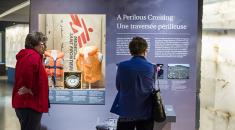Exploring with Teens Aged 13 to 17
There’s a lot to see and do at the Museum – more than can be done in a single visit. This section provides a guide for visiting with Teens aged 13 to 17, to help you plan your visit.
All exhibits in the Museum are suitable for ages 13 to 17. A parent or caregiver is best qualified to assess whether teens need adult supervision. We recommend that visitors aged 13 to 17 explore the Examining the Holocaust and Breaking the Silence galleries with a parent or caregiver because these galleries contain difficult knowledge.
The Museum is one of the most digitally advanced in the world. To explore the galleries using our award-winning technology, you can download the Museum’s free mobile app to a personal device, or borrow a device at the Ticketing and Information desk. The app provides access to additional content, including a mood meter to track how you feel during and after your visit.
Share your Museum visit on social media! Tweet your photos and thoughts using #VisitCMHR.
Here are some Museum highlights for teens:
Digital Kiosks
This Museum isn’t about passively receiving information. It’s about actively seeking insight based on what ignites your curiosity. In most galleries, you’ll find digital kiosks – touch-screen monitors where you can dig more deeply into topics that interest you by exploring videos, photos and additional content.
- In the Indigenous Perspectives gallery, look for touch-screen monitors near the circular theatre. You’ll discover how First Nations, Métis and Inuit youth from across Canada participated in creating the colourful spirit panels displayed on the outside of the theatre.
Films
Be sure to check out the short documentary films screened in small theatres inside the galleries. They provide dynamic introductions to the exhibits.
- Contemporary films and multimedia experiences will get you thinking about rights in your everyday life. In the What Are Human Rights? gallery, the multimedia show tells stories about people such as a Paralympic swimmer and a fair-trade business owner. In the Rights Today gallery, films explore cyber-bullying and representations of women in media.
- For films that deepen your understanding of historical events, you’ll want to catch Canada, Anti-Semitism and the Holocaust in the Examining the Holocaust gallery; Covering the Holodomor: Memory Eternal in the Breaking the Silence gallery; and Canadian Human Rights Journeys and Childhood Denied: Indian Residential Schools and Their Legacy in the Canadian Journeys gallery.
- You can broaden your perspective by learning about Indigenous worldviews in which all people and things are interconnected. The film Circle of Knowledge: A Good Life for Us All is presented inside the circular theatre in the Indigenous Perspectives gallery on a wraparound panoramic screen. Notice how even the sound wraps around you!
Interactive Experiences
- In the centre of the Canadian Journeys gallery, grab some friends and join in the motion-sensor Lights of Inclusion game. Watch how your movements activate a “bubble” of coloured light on the floor around you. What happens when you work together? Move apart?
- In the Protecting Rights in Canada gallery, discover how your opinions on landmark legal cases compare with those of your friends. The Rights in the Court Interactive Table, with its ring of video monitors, introduces you to controversial cases centred on issues such as hate speech and the right to die. Express your views by voting!
- In the Turning Points for Humanity gallery, check out the digital books – tall video monitors that look like four upright, open books. Try standing in front of one and use arm gestures to control the video. These stories are about collective action – people working together in protest movements such as Tears for Justice, which seeks justice for missing and murdered Indigenous women.
- Find the Breaking the Silence gallery on the other side of a dividing wall from the Turning Points for Humanity gallery. Here, you can explore the study table, an interactive touch-screen surface for multiple users. Choose a country on the map and uncover evidence about atrocities committed there. When you learn about rights violations that have been hidden or denied, you help shatter the silence about them.
- In the Actions Count gallery, your years of playing video games will serve you well! Choose an animated character and start role-playing on the It’s Your Choice interactive table. In this multi-player game, your character works to make a difference in the community. Could you translate this fun activity to a real-life project?
- Does music play a big part in your life, stirring your emotions and motivating you? In the Inspiring Change gallery, find the Music Listening Stations, grab a set of headphones and watch the video screen. You can choose songs by artist name, human rights theme or a colour relating to emotional response. Read the powerful lyrics as you connect with songs from the soundtrack of human rights struggles.










